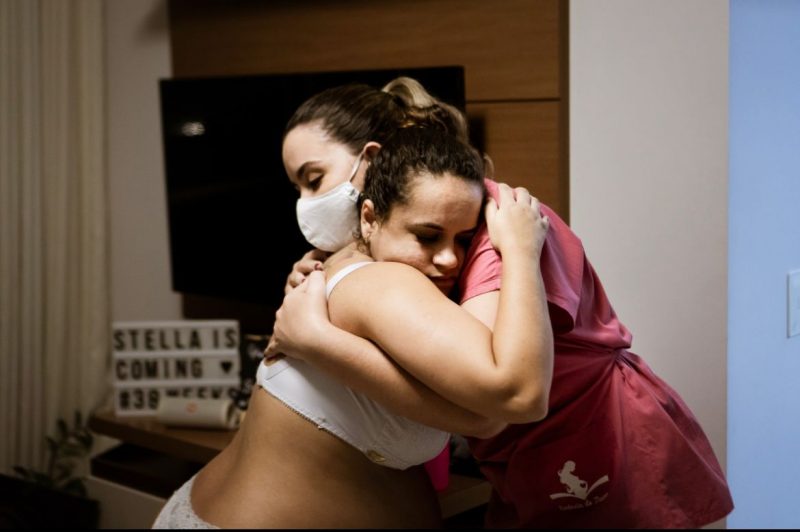
The arrival of a child is almost always an uplifting moment for most women. However, many of them face traumatic experiences associated with unnecessary interference, negligence, yelling, psychological, verbal and even physical abuse. And, even worse, comes from those who have to support and provide for them during pregnancy, childbirth and postpartum care.
Obstetric violence is characterized by physical and verbal aggression that occurs during the prenatal period, during childbirth, and even in the postpartum period. And it’s not just the figure of the doctor. It may also be practiced by nurses and administrative staff of a hospital or maternity ward.
 Obstetric violence is characterized by any act that is disrespectful to women before, during and after childbirth. Photo: Freepik/ND
Obstetric violence is characterized by any act that is disrespectful to women before, during and after childbirth. Photo: Freepik/NDProfessor Bruna Fani, 30, a resident of Florianopolis, was a victim of obstetric abuse in 2016 and has since made this topic the focus of her master’s studies in anthropology and her work. “Even though I have so much information about obstetric violence, it happened to me,” she says, who lost her son Vicente when he was 45 days old.
According to Bruna, the doctors were unanimous in her healthy and safe pregnancy. She says she felt insulted and disrespected during the birth and that as a result of the obstetric abuse, Vicente had consequences and had to be intubated. In addition, despite the urgency of the case, two long days had to wait for the neonatal intensive care unit so that the child could receive adequate treatment.
 Bruna Fani gave new meaning to Vicente’s death after suffering obstetric violence, and today she is committed to taking action against the practice – Photo: Divulgation/ND
Bruna Fani gave new meaning to Vicente’s death after suffering obstetric violence, and today she is committed to taking action against the practice – Photo: Divulgation/ND“He needed to be intubated, and in my city, in Rio Grande do Sul, there were no intensive care units. When Vicente died 45 days after birth, I stopped thinking about the experience and only then realized that I had become a victim of obstetric violence, ”she recalls.
Obstetric violence takes many forms
Gynecologist and obstetrician Guilherme Rossi explains that obstetric violence is characterized by any act of disrespect for a woman during childbirth before and during childbirth. “It is worth remembering that violence occurs not only with women, but also with the companion of this pregnant woman,” the doctor notes.
Following this line of reasoning, obstetric violence is considered a joke about the position of a woman in labor, a companion or an infant, as well as profanity and even previously unexplained medical procedures when humanized childbirth practices that are not recommended by the norms are accepted. “Early removal of a newborn from the arms of the mother after birth without any plausible or explained reason or without resolving your doubts during labor is also obstetrical abuse,” explains Rossi.
The exclusion of companions, except at the time when the patient needs pain relief, due to infection, also qualifies as obstetric abuse.
“After the woman in labor is given anesthesia, the cohabitant has the right to be next to her. In a caesarean section, doping a patient or using drugs that render her unconscious for no good reason is also obstetrical abuse,” he explains.
Practices not recommended by the WHO (World Health Organization) such as the Christeller maneuver, lithotomy, oxytocin administration and episiotomy may also be considered obstetric violence (*see definitions at the end of the report). Finally, any type of discrimination, use of drugs without need or consent, and aggressive communication also characterize this practice.
Obstetric violence is increasingly discussed, but little condemned
According to the IBGS (Brazilian Institute of Geography and Statistics), about 2,708,884 children were born in 2022, which is equivalent to 7,421 births per day. However, in the same year, only 288 cases of obstetric violence were reported in Brazil. In Santa Catarina, 12 women reported being victims of obstetric violence.
But this does not mean that there are few cases. Given the proportionality between birth rates and complaints, one of the reasons for the low number of cases may be due to underreporting, as many women do not report cases of violence or even indicate that they have been victims of domestic violence due to lack of information.
“Even with so much information, many women suffer from obstetric violence because they are vulnerable and do not even know what to do at the time, as the moment of childbirth can be very vulnerable. In some cases, they don’t even realize they’re suffering from obstetric abuse,” explains Barbara Berdine, doula and hypnosis instructor.
She says she works hard to inform and prepare patients. “Now the help of people who know the stages that mothers have to face is very important. That’s what doulas are for,” explains Barbara.
 Doula Barbara Berdine (wearing a mask and lab coat) while caring for a pregnant woman in normal labor – Photo: Publicity / Clareou Filmes / ND
Doula Barbara Berdine (wearing a mask and lab coat) while caring for a pregnant woman in normal labor – Photo: Publicity / Clareou Filmes / NDDoulas are professionals who accompany pregnant women before, during and after the birth of a child. A doula does not have to be from the healthcare industry, but should empower and support women in their choices with information and presence wherever a woman chooses to give birth.
Discrimination is the main cause of violence
According to Agência Câmara de Notícias, the Special Commission on Obstetric Violence and Maternal Mortality notes that black women, indigenous women and low-income women are the main victims of obstetric violence in Brazil. Black women are in the majority, with 171 complaints filed between 2018 and 2022. In Santa Catarina, four women reported violence during the same period.
According to the Nascer no Brasil survey, 45% of women who report being victims of domestic violence have been bullied in the SUS (Sistema Único de Saúde). In a private network, this figure drops to 30%.
During a speech, Santa Catarina’s current Minister of Health, Carmem Zanotto, attributed skin color to the quality of prenatal care. The former deputy also defended the discussion about obstetric violence in medical educational institutions.
 Black women suffer more from obstetric violence than white women — Photo: Freepik/ND
Black women suffer more from obstetric violence than white women — Photo: Freepik/ND“Black women die more often than white women. Even in cases of equal education and access to prenatal care. It has been proven that we as medical professionals spend less time on prenatal care for black women than for white women,” he said at the time.
Barbara Berdine makes a skin with a statement. “The majority of women who suffer from obstetric violence are black, also because some doctors believe they are more pain tolerant, in addition to a number of other problems associated with the birth process,” he adds.
Trauma and the feelings that remain
According to obstetrician Guilherme Rossi, the most common consequences of obstetric violence are psychological. “This is a process in which a woman is very vulnerable and insecure, so any type of aggression has immediate consequences with the possibility of irreversible psychological consequences,” he said.
Rossi also notes that many women subjected to such violence put their health at risk due to fear of repeat visits to the gynecologist and even re-delivery.
The physical consequences of obstetric violence are usually associated with reckless actions on the body of a woman during childbirth or without the correct clinical indications.
“For example, when a doctor puts pressure on a woman’s stomach, he can break her rib or cause pain in her stomach. Another example of this is chronic pelvic pain after childbirth as a result of circumcision, ”explains the specialist.
For Bruna, the immediate consequence of Vicente’s death was an undercurrent of resentment. “I was filled with rage. I felt the anger of all the medical staff. The same team that claimed to have become human saw me as just a number, just another,” says she, who sued the delivery team back in 2016. However, after seven years nothing has been decided.
“By the arrival of Vicente, the house had remained clean for a long time. And he will never come. Meanwhile, the lives of these people will go on. I wanted justice to prevail.”
Knowledge is the best defense against obstetric violence
Learning about humanized birth practices can help protect against obstetric violence. Rossi advises that the patient, if possible, establish contact with the gynecologist and explain her fears and insecurities.
“There is such a tool as a birth plan. This is usually a document given to a pregnant woman during antenatal care so that she can determine her preferences, such as the type of birth, agreed methods of pain management, accompanying whether there will be a doula or not, among other details, ”the specialist says.
Can grief be overcome?
“I don’t like the word overcoming because it doesn’t speak of grief. When we lose someone we love, there is no coping,” says Bruna, who went on to work for a mother mourning NGO.
“We often say that there is no end to maternal grief. We can’t predict when this will pass, there are days when I’m fine, and there are days when I think about how old my son will be or what he will be,” he laments.
For Bruna, society avoids truly knowing maternal mourning as people don’t open up to talk about death. “I rethought my life project. I am a mother and at the same time I am not. Because my son died, I lost my mother’s assignment? I recognize myself as a mother, even if he is not here. Love does not die when someone dies,” he emphasizes.
By reformulating her mourning for Vicente’s death, Bruna found a purpose in life. Get the word out about obstetric violence to as many people as possible and fight for as many other affected women and families as possible.
“I decided to fight this violence so that people don’t go through this anymore, to give up the fight, from my PhD thesis at the UFSC (Federal University of Santa Catarina), the topic of which is obstetric violence. During the time of activism, we managed to achieve the adoption of the law, we have achieved many achievements. Small changes may be, but the big seeds have been sown. Protect your rights, denounce, hire a lawyer, demand a public defender and, finally, meet places that welcome you more often, ”he concluded.
See methods not recommended by WHO (World Health Organization):
- Christeller’s maneuver: The technique involves pressing on the top of the uterus to “facilitate” the baby’s exit;
- Lithotomy: unfavorable position at birth;
- Serum with oxytocin: a synthetic hormone used to speed up uterine contractions;
- Episiotomy: A surgical incision made in the perineum at the end of a normal birth to “facilitate” the baby’s exit. In addition to being painful, the procedure leaves internal stitches that can cause urinary incontinence and pain.
Source: Ndmais